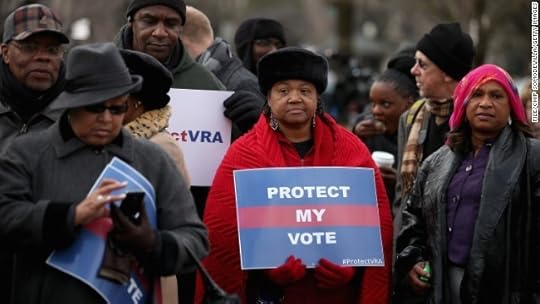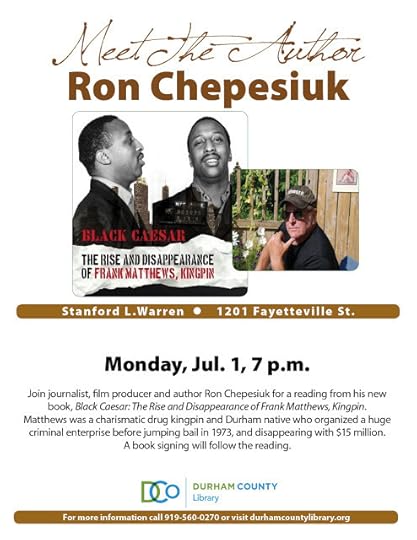Mark Anthony Neal's Blog, page 887
June 26, 2013
Texas Showdown: Anti-Abortion Bill Fails After Protesters Fill Capitol to Cheer Marathon Filibuster
Democracy Now
Democratic lawmakers and pro-choice demonstrators in Texas battled into the early hours of this morning to successfully block a bill that would have shuttered nearly all the state's abortion clinics. Senate Bill 5 would have banned abortion after 20 weeks post-fertilization and imposed harsh regulations forcing all but five Texas clinics to close down. On Tuesday morning, State Senator Wendy Davis donned a pair of pink tennis shoes and rose to her feet to launch a filibuster of the bill that lasted nearly 11 hours before Republican senators interrupted it. As the midnight deadline for the special session drew near, hundreds of protesters in the gallery erupted into cheers that drowned out the proceedings, but Republican lawmakers attempted to claim they had passed the bill anyway. Hours later, Lieutenant Gov. David Dewhurst conceded the vote had not followed legislative procedures, blaming what he called an "unruly mob using Occupy Wall Street tactics." Describing the raucous scene at the Capitol, Andrea Grimes, a freelance journalist who writes for RH Reality Check, says: "Once people at that filibuster began telling their stories and sharing them with others, that galvanized the pro-choice space and radicalized some people who hadn't realized how our rights were under threat." We also speak with Brandi Grissom of The Texas Tribune, who hosted the livestream of the senate proceeding that drew more than 100,000 viewers. Planned Parenthood President Cecile Richards tells Democracy Now!: "With the thousands of people who were mobilized this time around, they will be doubly that way if in fact Gov. [Rick Perry] tries to push [the bill] through again in another special session. And if he does, we'll be ready."
Published on June 26, 2013 08:24
June 25, 2013
North Carolina Youth Demand Action from NC Governor
Forward Together
June 19th, 2013 - North Carolina students and young people march to the State Capitol from the historic St. Paul AME Church to petition Gov. Pat McCrory to veto or reverse extreme and regressive legislation from the NC General Assembly that will adversely hurt thousands of North Carolinians. They will be returning on June 26th for a response.
Published on June 25, 2013 18:47
The New York Times: A Video History of Voting Rights
The New York Times
For much of the 20th century, voting remained a contentious issue, but the Supreme Court struck down Section 4 of the 1965 Voting Rights Act on Tuesday, suggesting that conditions have changed.
Published on June 25, 2013 18:38
Segregated Education in Desegregated Schools: Why We Should Eliminate "Tracking" With "Gifted & Talented" for All
 Segregated Education in Desegregated Schools:
Why We Should Eliminate "Tracking" With "Gifted and Talented" for All
by Alan A. Aja, William “Sandy” Darity Jr. and Darrick Hamilton | HuffPost BlackVoices
Segregated Education in Desegregated Schools:
Why We Should Eliminate "Tracking" With "Gifted and Talented" for All
by Alan A. Aja, William “Sandy” Darity Jr. and Darrick Hamilton | HuffPost BlackVoicesIn the 1969 Supreme Court ruling Alexander vs. Holmes County Board of Education, a unanimous court ruled that a Mississippi school district "terminate dual school systems at once and to operate now and hereafter only unitary schools." The ruling, a mandate for non-compliant segregationists, was supposed to finally reverse the tide of Jim Crow era "separate and unequal" education.
Today, while more students generally attend racially and economically diverse schools, it is no secret that our schools are anything but unitary. According to recent reports by The Civil Rights Project at UCLA, concentrations of Blacks and Latinos into resource-deprived schools are at unprecedented levels, reversing years of progress toward integration since the monumental Brown v. Board (1954) and subsequent decisions. But while more recent Supreme Court decisions from Oklahoma City, Louisville, KY and Seattle, WA and policy-level failures such as No Child Left Behind (NCLB) are rightfully viewed among myriad protagonists of these trends, often overlooked by integration advocates is the reality of "dual school systems" operating at the curricular level, not just at the facility level.
Take for example the case of Southwest Elementary School in Durham, North Carolina. When David Snead began his tenure as principal in 1999, he discovered that 98% of the school's white students and only 7% of black students were identified as "gifted and talented" (G&T), therefore placed in a separate, challenging curriculum. More astonishingly, this was in a school where blacks represented over 70% of the student body, while whites represented only 30%.
Snead, who is white and male, came face to face with one of America's long-embedded institutional-level responses to integration: racialized tracking. And rather than accept internal segregation as an everyday norm, one grounded in the still-prevalent belief that minority students are "cognitively inferior" (or for self-professed non-racists, that they purposely under-perform out of fear of "acting white"), Snead believed otherwise. The principal worked with the school's teachers to alter ways they thought about "giftedness," given that their assessment triggered consideration for subsequent testing into advanced curricula. The results were astounding.
By 2003-2004, 60% of the school's black students were identified as G&T, while 40% of white students were identified as such. Moreover, the impact of the change was evident in the school's performance on state test scores. In 1999-2000, 41% of the school's fifth grade black students did not pass the state reading test compared to 12% for white students, and 23% of blacks did not pass the mathematics test compared to 9% for whites. By 2002-2003, only 10% of both black and white students did not pass the reading test, and less than 3% did not pass the mathematics exam. Indeed, the new structure was even associated with improved pass rates for white students.
Southwest Elementary achieved something remarkable: they eliminated the racial achievement gap by eliminating the instruction gap, and they did it even though most white students, on average, came from affluent, two-parent families while most of the school's black students did not. In fact, during Snead's tenure, the proportion of students eligible for free or reduced lunches increased for its black students, but decreased for its white students.
On the surface, examples like that of Southwest Elementary should impel policymakers to address the chronic problem of segregated curricula in our schools. In New York City, for instance, some mayoral candidates and parent organizations have called for improved minority access to the city's popular G&T programs, which are demographically dominated by white and Asian students. But a bold response isn't one that simply improves access and opportunity, but one that eliminates tracking altogether and provides "gifted and talented" education for all. In short, schools should de-track toward excellence for all students.
In North Carolina, for instance, such an endeavor was launched in some of the state's lowest income school districts, and the preliminary evidence is striking. Project Bright Idea, created by state educators in collaboration with experts at the University of North Carolina at Chapel Hill and Duke University, sought to test whether raising expectations could enhance student performance regardless of race or socioeconomic background. The program, which operated from 2004-2009 in 11 North Carolina school districts, enrolled 5,000 kindergarteners and first and second graders from disproportionately low-income communities. Meanwhile, teachers underwent intensive training and development to address their dispositions about the abilities of black and impoverished children while providing the schools and teachers with the resources and capacity to deliver a high level of instruction for all children.
David Snead and Project Bright Idea's intervention demonstrate that kids, regardless of family arrangement and poverty status, can do well academically with a challenging curriculum and instruction predicated on the belief that they can master complex material. But to work effectively on a larger-scale, additional teacher training and development must be prioritized and funded, which means efforts by education reformers to fire teachers based on high-stakes testing (standardized test scores) must come to an immediate halt. If we are to reverse the tide of internal segregation in our schools, we must ensure that teachers are prepared and trained to provide a high quality education to ALL students, not just a select few.
Authors’ Note: the case of Southwest Elementary, along with a similar example out of Rockville Centre High School in Long Island, NY, is documented by William Darity, Jr. and Alicia Jolla in "Desegregated Schools with Segregated Education," in Hartman, Chester and Gregory Squires, The Integration Debate: Competing Futures for America's Cities. Routledge Press, 2009.
***
Alan A. Aja is an Assistant Professor and Deputy Chair in the Department of Puerto Rican & Latin@ Studies at Brooklyn College (City University of New York).
Darrick Hamilton is an associate professor of economics and urban policy at The New School, an affiliate scholar at the Center for American Progress, and a research affiliate at the Research Network on Racial and Ethnic Inequality at Duke University.
William A. (“Sandy”) Darity Jr. is Arts & Sciences Professor of Public Policy Studies and Economics, Chair of African and African American Studies and director of the Research Network on Racial and Ethnic Inequality at Duke University.
Published on June 25, 2013 16:30
Tell Me More: Voting Rights Act: Supreme Court Says Times Have Changed
Published on June 25, 2013 13:19
Trailer: 'Plot for Peace' (dir. Mandy Jacobson & Carlos Agulló, 2013)--the Untold Story of the Release of Nelson Mandela from Prison
Plot for Peace
This is the untold story behind History, a well-kept secret behind the world-wide icon: Nelson Mandela's release was a 'Plot for Peace.'
For the first time, heads of state, generals, diplomats, master spies and anti-apartheid fighters reveal how Africa's front line states helped end apartheid. Their improbable key to Mandela's prison cell was a mysterious French businessman, dubbed "Monsieur Jacques" in classified correspondence. His trade secret was trust.
Mandy Jacobson: Producer/Director
The Executive Producer of the African Oral History, Mandy is a multiple award winning filmmaker, who works out of both New York and Johannesburg. Won two Emmy Awards for her documentary Calling the Ghosts: A Film about Rape, War and Women in Bosnia (HBO / Cinemax) and with the Bill Moyers team won the Peabody for PBS feature, Facing the Truth. She has produced and directed programs in the US, Brazil, Bosnia, Rwanda, Bangladesh, Cuba and South Africa, which have been broadcast on major networks worldwide, including CBS‘s Sixty Minutes, PBS, ARTE, Discovery, SABC and ETV. Mandy is heads Indelible, Media, a multi-media production company dedicated to showcasing African cinema and television for international broadcast and theatrical release.
Carlos Agulló: Director/Editor
Carlos is part of the lively core of Spanish auteur cinema increasingly being recognized outside its borders. He worked as an assistant editor “The Sea Inside” by Alejandro Amenábar, which won the Academy Award for Best Foreign Film and later as film editor for other award winning Spanish Directors such as “Back to Moira” by Mateo Gil, “Planet 51” by Jorge Blanco, “Historia de un Director Idiota” by Sergio Candel,“For the Good of others” by Oskar Santos and the TV series “Crematorio” by Jorge Sánchez Cabezudo. He has also directed several of his own short films such as “The Gift”, “The Wait”, “Ana Cronia” “Pizza Eli” and “Next Station”.
Stephen Smith: Scriptwriter/Historical Consultant
An academic, journalist, and writer, he worked as Historical Consultant for Olivier Assaya’s film “Carlos”, which premiered in Cannes in 2010 and won a Golden Globe and Emmy Award in 2011. As an adviser for Africa, he also contributed to Ben Moses’ “A Whisper to a Roar”, released at the Berlin film festival in February 2012. Since 2007, he teaches African Studies and Cultural Anthropology at Duke University and, as an adjunct Professor, at Johns Hopkins School of Advanced International Studies (SAIS) in Washington DC. Prior to becoming the Africa editor of the French daily Libération and then Le Monde, he worked as a correspondent for Radio France International (RFI) and Reuters in West and Central Africa. He is the author of sixteen books, among them a biography of Winnie Madikizela Mandela (2007), and a regular contributor to The London Review of Books.
Published on June 25, 2013 05:44
June 24, 2013
Patti LaBelle & The Bluebells: "Somewhere Over the Rainbow" (1968)
via UK Vibe
Published on June 24, 2013 19:21
Black Caesar: The Rise & Disappearance of Frank Matthews—Meet the Author Ron Chepsiuk on July 1st
Published on June 24, 2013 14:39
Style Hunt: Brixton, London
iamOTHER
This week, Style Hunt travels to Brixton, London — that rare kind of neighborhood where you can find a Great Gatsby-refrencing dandy, a 1970s style sewist and green-and-gold wearing rastafarian on the same block. Created by Metro International's style director Kenya Hunt, presented byModMods.com.
Published on June 24, 2013 10:28
Mark Anthony Neal's Blog
- Mark Anthony Neal's profile
- 30 followers
Mark Anthony Neal isn't a Goodreads Author
(yet),
but they
do have a blog,
so here are some recent posts imported from
their feed.





